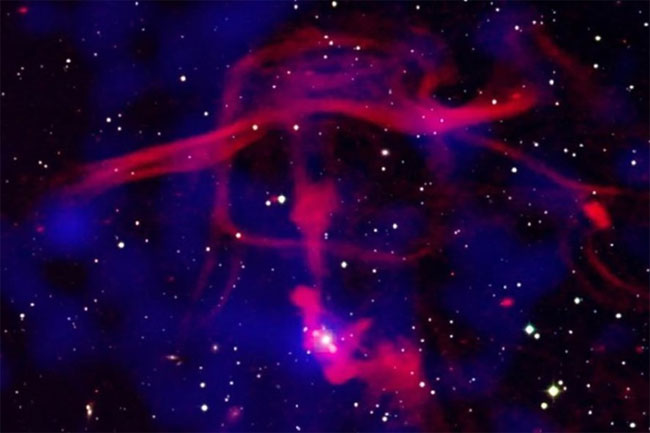A new study reveals that gas bubbles emitted by cosmic black holes spread across vast distances in the space between galaxies and influence star formation.
According to Space.com, astronomers know that black holes pull in matter from their surrounding environment due to their powerful gravitational forces. Previously, they also noted that some of this matter escapes the black hole at near-light speed in the form of charged particles.

A gas jet created by a black hole in the Nest200047 galaxy cluster, spreading through the intergalactic space. (Image: ASTON).
However, it wasn’t until this new study that they recorded in detail how these materials spread throughout the intergalactic space over hundreds of thousands of light-years. This process is somewhat similar to how ash clouds from volcanic eruptions on Earth spread through the atmosphere and affect weather patterns on distant continents.
Marisa Brienza, the lead author of the study and a researcher in the Department of Physics and Astronomy at the University of Bologna, Italy, stated: “Our investigation shows how gas bubbles accelerated by black holes expand and transform over time. Indeed, they create spectacular structures resembling mushrooms, rings, and filaments, similar to structures originating from a massive volcanic eruption on Earth.”
These new insights were made possible through radio observations from the Low Frequency Array (LOFAR) and the eROSITA X-ray space telescope.
The gas bubbles observed in this study emanate from a black hole at the center of a galaxy cluster named Nest200047. This black hole, located about 200 million light-years from Earth, pulls in matter from its surroundings while simultaneously emitting powerful jets that consist of charged particles and hot gas.
Using LOFAR, astronomers were able to observe how these jets create gas bubbles, which over time transform into filament-like structures as they drift away from the black hole and interact with objects in the surrounding space. These observations were combined with images from eROSITA, the first space telescope capable of capturing X-ray radiation across the entire sky.
Timothy Shimwell from the Netherlands Institute for Radio Astronomy (ASTRON), which manages LOFAR, commented: “For many years, researchers have been trying to understand how far-reaching the influence of a black hole can be. The images we created of this incredible system show that the answer is astonishingly large. Black holes not only affect the host galaxy but also impact the vast intergalactic environment—regions that can contain hundreds of other galaxies—and influence aspects such as the rate of star formation in those galaxies.”
According to astronomer Huub Rottgering from Leiden University (Netherlands), this is a remarkable scientific breakthrough.
The study was published on October 18 in the journal Nature Astronomy.


















































